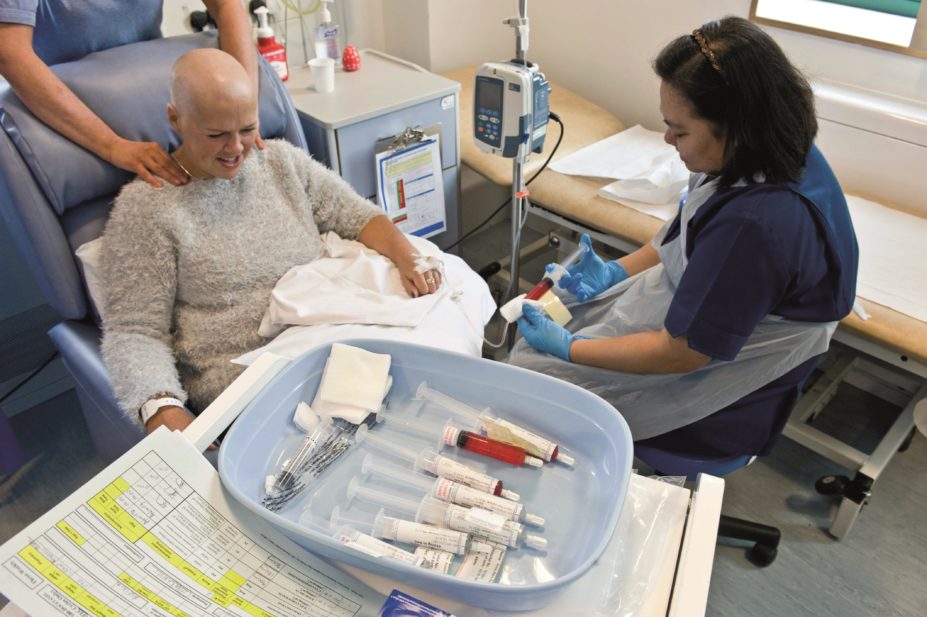
Paul Springett A / Alamy Stock Photo
NHS England has carried out its much anticipated second assessment of the Cancer Drugs Fund (CDF), further reducing the list by 17 drugs for 23 different indications.
The CDF was launched in 2010 to allow access to innovative drugs that are otherwise unavailable, but expected budget shortfalls prompted a review that has led to drugs being eliminated from the list.
The fund’s budget increased from £200m in 2013 to £340m in April 2014, but spending is expected to increase to £410m in 2015, an overspend of £70m.
“Since its introduction, the CDF has helped tens of thousands of patients in England access vital… drugs needed to treat or control their cancer,” says Thomas Cottam, policy manager at Macmillan Cancer Support. “However, it was never intended to be a long-term solution.”
An NHS spokesman says: “We all recognise that the CDF has been successful by ensuring people with cancer in England have access to the same treatments as people across Europe.
“This second round of de-listing speaks to the need to reform the CDF, and we are ready to play our part in ensuring this happens.”
Despite these cuts, NHS England does not expect the budget to be back on track until the 2016-2017 financial year.
The cuts have provoked anger from charities and pharmaceutical companies, leading to claims that the system is no longer fit for purpose.
“Today’s decision is an example of the confusion at the heart of our drug assessment system – with some treatments first being refused by the National Institute for Health and Care Excellence (NICE), then accepted on to the CDF and now to be removed from the list and denied to new patients,” says Paul Workman, chief executive at the Institute of Cancer Research.
Companies and charities alike are calling for all stakeholders to work together to find a better solution for patients.
“This has been a unilateral decision by NHS England. What is missing is a willingness for all stakeholders to take part in collaborative discussion and work together,” says Wim Souverijns, general manager, Celgene UK & Ireland. “There is a role for companies to put pressure on stakeholders, including NICE and NHS England, to point out the implications of these changes.”
Celgene’s Imnovid (pomalidomide) and Revlimid (lenalidomide) for relapsed and refractory multiple myeloma, and Abraxane (nab-paclitaxel) for metastatic pancreatic cancer, have been cut from the list (see panel).
Souverijns accepts that companies need to deliver value for money, but sees these decisions as being based on a drug’s cost rather than its value. He suggests that curtailing access to certain drugs such as Abraxane could have a knock-on impact on clinical trials running in the UK, by limiting the choices of comparator drugs.
NHS England also recognises the need for change, saying, “The CDF was never meant to be a long-term approach to funding cancer medicine.”
It added: “We need to work together to put in place a pragmatic, flexible and sustainable system – one that puts patients first and one that works for clinicians, government, NHS, patient groups and companies.”
Roche, whose drug Kadcyla (trastuzumab emtansine) for breast cancer has been removed from the list, said it is looking for sustainable, flexible and pragmatic solutions to get innovative drugs to patients. Daniel Thurley, medical director at Roche Products, said in a statement that access to these innovative cancer medicines will only be achieved through long-term reform.
The CDF panel, on which sit oncologists and other experts, assessed 27 drugs for 43 separate clinical uses, where some drugs are used to treat more than one cancer. It ruled that 16 drugs for 22 separate clinical uses should be removed from the list – one additional treatment should also be removed because it is no longer used. It said 15 drugs for 20 different clinical uses should stay on the list.
A NHS England spokesperson said: “Manufacturers of 9 of these 16 drugs in the case of 12 separate clinical uses have the opportunity to drop the price they are asking the NHS to pay and the drug will be retained.”
| Cancer drug cull | |
|---|---|
| Drug | Indication |
| Source: NHS England | |
1. Albumin-bound paclitaxel | 1. Advanced pancreatic cancer |
2. Bendamustine | 2. Chronic lymphocytic leukaemia 3. Mantle cell non-Hodgkin’s lymphoma |
3. Bevacizumab | 4. Recurrent or metastatic cervical cancer 5. Advanced breast cancer 6. Advanced colorectal cancer |
4. Bosutinib | 7. Chronic phase chronic myeloid leukaemia 8. Accelerated phase chronic myeloid leukaemia |
5. Brentuximab | 9. Refractory systemic anaplastic lymphoma 10. Relapsed or refractory CD30+ Hodgkin’s lymphoma |
6. Cetuximab | 11. Metastatic colorectal cancer |
7. Dasatinib | 12. Philadelphia chromosome positive (Ph+) acute lymphoblastic leukaemia |
8. Everolimus | 13. Metastatic renal cell carcinoma |
9. Ibrutinib | 14. Relapsed/ refractory chronic lymphocytic leukaemia 15. Relapsed/ refractory mantle cell lymphoma |
10. Lenalidomide | 16. Multiple myeloma |
11. Ofatumumab | 17. Chronic lymphocytic leukaemia |
12. Panitumumab | 18. Metastatic colorectal cancer |
13. Pegylated liposomal doxorubicin | 19. Named sarcomas |
14. Lutetium177 octreotate or yttrium90 octreotide/octreotate | 20. Advanced neuroendocrine tumours |
15. Pomalidomide | 21. Relapsed and refractory multiple myeloma |
16. Radium-223 dichloride | 22. Castration-resistant prostate cancer |
17. Ado-trastuzumab emtansine | 23. Locally advanced/unresectable or metastatic breast cancer |
You may also be interested in

Tackling the NHS drug budget: why we set up a regional collaboration for medicines value

Lack of joined-up working between pharmacy and general practice is ‘nonsensical’, says former BMA chair
